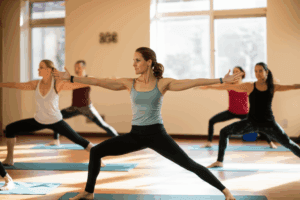Recent studies have highlighted a significant link between physical fitness and improved survival rates for individuals diagnosed with cancer. Maintaining good muscle strength and cardiovascular fitness can dramatically reduce the risk of death from cancer, offering a powerful tool in the fight against this disease.
The Power of Physical Fitness
A comprehensive analysis of 42 studies, encompassing nearly 47,000 cancer patients, has revealed that those with higher levels of muscle strength and cardiorespiratory fitness (CRF) experienced a remarkable 31-46% reduction in the risk of all-cause mortality compared to individuals with low fitness levels. This research, published in the British Journal of Sports Medicine, underscores the profound impact of physical activity on cancer survival.
Muscle Strength as a Key Indicator
Muscle strength, often assessed by handgrip strength, has emerged as a crucial factor. The studies classified low strength as anything from under 13kg to under 25.1kg in women, and anything under approximately 20kg to 40kg in men, depending on the specific study. Those with higher handgrip strength demonstrated a considerably lower risk of death. Moreover, each unit increase in muscle strength was associated with an additional 11% reduction in mortality risk.
Cardiorespiratory Fitness Matters
Cardiorespiratory fitness (CRF), typically measured through VO2 max tests or walking tests, also plays a vital role. The research indicated that improved CRF levels were linked to an 18% decrease in the risk of cancer-specific mortality for each unit increase.
Impact Across Cancer Stages and Types
The positive effects of strength and fitness are not limited to early-stage cancers. Remarkably, even patients with advanced-stage cancer saw an 8-46% reduction in the risk of all-cause mortality when they possessed good muscle strength and CRF. Additionally, individuals battling lung and digestive cancers showed a significant 19-41% reduction in mortality risk.
How Exercise Helps
Beyond the statistical findings, it’s essential to understand how exercise combats cancer mortality. Regular physical activity can help:
- Reduce Cancer-Related Fatigue: Cancer and its treatments often cause debilitating fatigue. Exercise can help combat this, boosting energy levels and overall well-being.
- Improve Muscle Mass: Cancer and treatments can lead to muscle loss. Strength training helps maintain and build muscle mass, which is critical for overall health and function.
- Enhance Cardiovascular Health: Exercise, especially aerobic activity, is vital for heart and lung function, counteracting potential side effects of cancer treatments.
- Improve Overall Quality of Life: Exercise can have a positive impact on mood, reduce anxiety and depression, and promote better sleep.
- Support Immune Function: Regular physical activity can improve the body’s immune response, potentially aiding in cancer recovery.
Exercise Recommendations
International guidelines recommend that people with cancer aim for:
- 150 minutes of moderate-intensity activity per week: This could include activities like brisk walking, cycling, swimming, or gardening.
- 75 minutes of vigorous-intensity activity per week: Activities like running, aerobics, or fast cycling are beneficial.
- Strength training sessions 2-3 times per week: Incorporating resistance exercises using weights, bands, or bodyweight can help maintain and build muscle mass.
It’s important to start slowly and gradually increase activity levels, always consulting with a healthcare provider before beginning any new exercise program, especially when dealing with cancer.
Strength Training: A Vital Component
Strength training, also known as resistance training, is crucial for cancer patients. This type of exercise can help maintain or increase muscle mass, improve balance, reduce fatigue, and make daily activities easier. Strength training can involve using hand weights, exercise machines, resistance bands, or bodyweight exercises.
Building Muscle After Cancer Treatment
Developing an exercise routine can be beneficial at any stage of the cancer journey. A strength training program can improve muscle strength before cancer care begins, help to maintain strength during treatment, and aid in recovery and reduce the risk of cancer recurrence after treatment. The goal of rehabilitation therapy is to tailor the program to fit a person’s needs and lifestyle.
The Broader Impact of Physical Activity
The benefits of physical activity extend beyond cancer survival. Exercise also contributes to:
- Reduced risk of falls and osteoporosis: Strength training improves bone density and balance, reducing the risk of falls and fractures.
- Healthier metabolism: Muscle mass is associated with a healthier metabolism, aiding in weight management and overall metabolic health.
- Stronger heart: Both aerobic exercise and strength training contribute to a stronger and healthier cardiovascular system.
Key Takeaways
The evidence is compelling: physical fitness, encompassing both muscle strength and cardiorespiratory fitness, is a significant factor in improving survival rates for individuals diagnosed with cancer. The research suggests that incorporating tailored exercise programs into cancer treatment plans could lead to substantial reductions in mortality.
As the number of cancer diagnoses is projected to rise, with an estimated half a million more people living with cancer in 2025 compared to 2020, the importance of maintaining strength and fitness cannot be overstated. These findings should be shared widely to help those at risk make informed decisions about their health.
While cancer treatments have advanced, the impact of those treatments on muscles and cardio fitness can take their toll on patients, making fitness more important than ever.
In conclusion, embracing a physically active lifestyle, with a focus on both strength and cardiovascular fitness, offers a powerful strategy for people with cancer to not only improve their survival rates but also enhance their quality of life.







